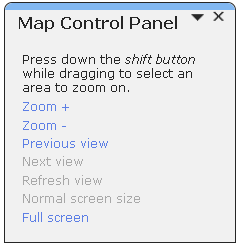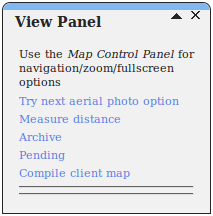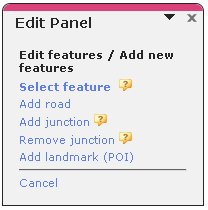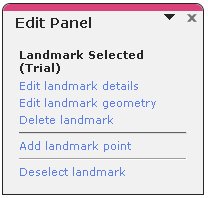Kentsmith9 (talk | contribs) (Red warning) |
Kentsmith9 (talk | contribs) (Reformated obsolete template) |
||
| Line 1: | Line 1: | ||
{{Red|IMPORTANT: This page refers to the old web-based map editor, Cartouche. Please see the [[Waze Map Editor]] documentation for the most up-to-date information on using the new editor. | {{Red|IMPORTANT: This page refers to the old web-based map editor, Cartouche. Please see the [[Waze Map Editor]] documentation for the most up-to-date information on using the new editor.}} | ||
{{ToObsolete}} | |||
==What is the Cartouche?== | ==What is the Cartouche?== | ||
Revision as of 06:35, 26 April 2013
IMPORTANT: This page refers to the old web-based map editor, Cartouche. Please see the Waze Map Editor documentation for the most up-to-date information on using the new editor.
| This information is obsolete and the active links to this page are being reviewed for disconnection or replacement. |
What is the Cartouche?
The cartouche is the interface which is used to edit the map.
The cartouche holds different tools that provide information and editing options for the existing map.
To edit the map, click on Update Map, next to Live Map, above the upper left corner of the map screen.
Components, layers and tools of the map
Selecting Multiple Roads
Some edits require that you select two or more segments of road.
- Mac: Command + Click
- Windows: Ctrl + Click
- Linux: Window-Key + Click
Keyboard Shortcuts
Template:Keyboard shortcuts Cartouche
Super Permalink
You can share your view of the cartouche by creating a link that contains the same view and with the same layers that are currently enabled. Click on the Super Permalink button at the bottom of the map. This option will create an address in the browser address bar. Copy this address and use it later, or send it by e-mail to other mappers.
NOTE: the permalink does not contain information about using normal screen view or full screen view (see Map Control Panel).
Coordinates line
Shows the specific point where the cursor is located by coordinates of longitude and latitude. Clicking the copy icon to the right of the coordinates - will display the line coordinates in a separate window.
To enable the copying:
- Highlight the line using the mouse.
- Click on the right mouse button.
- Select copy.
- Paste the coordinates wherever you choose.
Error creating thumbnail: File missing
Location pane
Shows a general location of the editing area.
Dragging the view box in the location pane will move the map in the main view to the selected location.
Zoom scale
Allows control over the zoom level.
You can also control the zoom by using the scroll button of the mouse (scroll).
You can select a specific area of focus by pressing the Shift key and marking the area with the mouse at the same time.

Map control panel

This panel allows basic control of the map view.
Zoom +: enlarges the area selected in one notch.
Zoom -: reduces the area selected in one notch.
Previous view: returns the previous viewing point for the zoom and map location.
Next view: performs the inverse operation when using "previous view".
Refresh view: Refresh the map window.
Normal screen view: returns the map window to its original size (after selecting Full screen).
Full screen: Increasing the map view window to the maximum (defined by screen resolution).
View panel

The view panel allows different display capabilities on the map layers operated in accordance with the different types of edits committed on the map.
Opening different layers will open different options on the View panel.
Four elements appear regularly in this panel:
Try next aerial photo option:
This option appears to be disabled due to the new aerial image source being used!
Allows you to scroll through different aerial images.
In some cases there is a different aerial image available which can be more optimal for your editing process.
Each click on this option will change the aerial image to the next available one.
Note that the aerial images scroll in a loop. After the last optional image was presented, the first image will be presented again.
Measure distance:
Allows to measure distance over the map.
After selecting Measure Distance from the View panel - click on the map at a certain point. The measurement will start from that point, and every additional click will create a joint point.
Double-click to finish the measurement. While measuring, the distance will be displayed on the view Panel.
To exit the measurement tool, press cancel.
Archive:
Selecting this option will show you a table of all the tracks that you drove and were processed by the cartouche. From the archive table, you can click on the map icon to display each archived route over the map.
Highlight Connectivity:
This tool allows to see if a specific segment is connected to any segments in its surroundings, and the allowed driving directions.
While this option is checked in the view panel, the connections are displayed over the map itself. After checking the Higlight connectivity checkbox in the edit panel, clicking on any segment over the map will also highlight segments around it (if any are connected).
An orange segment means driving is allowed from the orange segment to the segment you chose.
A green segment means driving is allowed from your selected segment to the green segment.
This tool is very useful and important when making map edits, and should be checked whenever you are working on the map. Error creating thumbnail: File missing
In order to connect two roads that are not already connected, select them both in the order they should be connected (using control+click to select multiple roads) and choose "Connect roads by order of selection" from the edit panel.
To disconnect a road from an intersection, choose the road and then control+click on the intersection (node), and choose "Disconnect road from node" from the edit panel.
Edit panel
This panel is a dynamic menu that allows you to update and change the map elements, depending on the elements selected on the map itself (for example - road segments, nodes, map problems and other markings – depending on the active layers).
If no element was selected on the map, the edit panel will show the option Edit features / Add new features.

Selecting this option will allow you add new elements to the map.
Select feature - Not active.
Add road: allows to add a new road to the map.
NOTE: adding a new road by this method is limited by GPS points. You cannot draw a new road in an area where no one drove before.
- Make sure that no element was selected on the map.
- Click on the add road and than click once at the point of the map where you want to start sketching the road. (note that the mouse cursor will change to black). Every additional click will add a joint to the road's sketch. To finish the sketch just double click at the point you want the new road to end.
- The edit panel will automatically show a new table with all the data that is necessary to create the new road. This information includes:
- Type of road
- City name
- Street name
- Direction of traffic.
- After filling in all the information, confirm by clicking on create new road. You might be required to confirm a new street name, if this street does not exist in our maps yet.
- Edit the road shape (if needed) by clicking on edit road geometry on the edit panel.
- Connect to new road to the other roads on both of its ends.
- Make sure that the direction of the other roads that are now connected to the new road is correct and allows navigation. Check the highlight connectivity in the view panel to make sure that all the road segments are properly connected.
Add junction:Allows to create an intersection node on a segment.
To add a new junction:
- Make sure that no elements are selected on the map.
- Click on the Add junction option
- Click on the segment wherever you want to place the intersection.
- Confirm.
Remove junction Allows you to remove a node which is no longer necessary.
To remove a junction:
- Make sure that no elements are selected on the map.
- Click on the Remove a junction option
- Select the node you wish to remove
- Confirm.
Add landmark (POI):allows to mark important sites on the map (gas stations, museums, parking lots etc.) to allow navigation to these sites.
Marking these sites will allow the program to find those sites just by typing their names and without typing their exact address.
To add a new landmark:
- Make sure that no elements are selected on the map.
- Click on add landmark
- Click the point on the map where you want to start the sketching of site
- Every additional click will add a new angle to the geometrical shape. Sketch the entire site.
- To end the sketch double click at the last angle point.
- The edit panel will automatically show a new table with all the data that is necessary to create the new landmark.
This information includes :- Type: the type of site you added
- Name: the name of the site
- English name: the name of the site in English (if relevant)
- Details: any additional information about the site that may help other users (entrance to a parking lot, w.c , restaurants etc.)
- When you finish entering the details select Create new landmark at the bottom of the panel.

Layers panel
The layers panel is a tool for controlling layers of information that will be displayed on the map.
Each layer contains relevant information to help view and control the map editing. You can select the layers that you want to display or remove.
You Can choose which layers will appear above the other layers by selecting the layer and dragging the mouse above the other layers.

Speed cams layer 
Selecting this layer will show on the map speed cameras which were reported by the users.
clicking on the camera icon will show the editing option on the edit panel
Editing option:
- Update the speed limit of the specific road.
- Delete the camera if its location is incorrect.
Note that you can not add new speed cameras when editing the map. You can add new speed cameras only when marking its location with your cell phone while driving next to it.

Restricted turns layers 
NOTE: The Restricted Turns layer is not currently operational and should not be used for determining actual turn restrictions. Use the Highlight Connectivity functionality instead. Dec. 2010.
The remainder of this section was deleted by AlanOfTheBerg on June 8, 2011 due to on-going lack of applicability to map editing.
Update Requests Layer
Update requests are requests that the waze users added to the live map in certain places.
When choosing a road on the live map, a user has the option to Report a problem.
Using this enables the user to report problems such as: update name, a street is missing , road fix, missing settlement and other. Usually a text description is also added to the update request.
Another option to report a problem is using a mobile phone with waze. In every step on the navigation users can report problems by entering the 'update map' interface from the waze client.
In case that an update request has been sent, it will be shown on the edit map as a circle, where each color represents a different status:
- Red – open problem : the problem is new or wasn't treated yet. As time passes the problem will grow more circles around it.
- Yellow – field trip needed : a solution for the problem is not possible because there is not enough information to solve the problem. It's necessary to drive in that area in order the map it better.
- Blue – missing data : not enough information to understand and solve the problem.
When selecting the update request icon, the edit panel will show:
- Update type: the type of problem that the user chose.
- Free text window: if the user wrote any comments about the problem (free text).
- Answer window: this is where you can answer the user who opened the request.
- Update state: the status of the current request.
- Open for: how many days have passed since the request was first sent.
- Name: the name of the user who opened this request.
Clicking on Save changes will update the request and send an e-mail automatically to the user who opened the update request.
Click here to get the RSS feed of Update Request in your area

House numbers layer
This layer shows the updated house numbers updated by the users, and those that came with the base map (where one exists).
You can update house numbers using waze from the phone using the 'update map' option from the phone.
You can also update house numbers from cartouche by clicking on a segment and then Update address number from the edit panel. Even though the entire segment will be highlighted, the house numbers will be updated on the exact point where you clicked the mouse.
Error creating thumbnail: File missing
An arrow will be displayed over the map, and you will have the option to update the house number to the right and to the left of the arrow.
Error creating thumbnail: File missing
Users notes
Currently not in use.
Map problems layer
There are two types of road problem:
Scan problems - problems 1-31
Merger problems - problems 51-60
selecting the map problems layer will show different icons with different numbers and colors. Each number represents a different problem type. To learn how to solve these problem, follow the links above.
The problems are colored in three colors:
yellow- low priority
orange – medium priority
red – high priority
 The priority level of the problem is determined by the number of users experiencing the same problem in that area.
In other words, as the number of people experiencing a problem in that area gets bigger, the priority level of the problem will grow.
The priority level of the problem is determined by the number of users experiencing the same problem in that area.
In other words, as the number of people experiencing a problem in that area gets bigger, the priority level of the problem will grow.
Selecting the map problem layer will show the problems on the map.
When the layer is on , several options will be shown on the view panel under map problems:
- Type – allows you the choose the type of problem you want to display over the map:
- All – all kinds of problems.
- Scan – will show only scan problems.
- Merger – will show only merger problems.
- Problem # - will show only the specific type of problem that was chosen.
- Coloring – should be always in priority mode.
Note that low priority problems will not be displayed on the map.
To view a low priority level problems should be marked with V option Show low priority.
Resolved problems will not be shown on the map.
It is possible to display the problem that came up in the last x days by defining it in the appropriate line square - in the last ____ days , at the bottom of the view panel, and clicking on filter.
Checking the next to my roads check box will display problems that came up next to roads that you drove on.
Recent GPS points layer
Selecting this layer will show only gps session points that been made in the past 30 days. Currently not in use.
Landmark layer
Selecting this layer will display on the map sites that been defined by users.

Unknown roads layer
Selecting this layer will display roads that were recorded by different users but have not been edited yet.
These roads will be shown on the map as red roads and can be edited by selecting them and editing them in the edit panel, similar to editing of any other road.
The unknown roads will also be displayed as part of the roads layer.

Roads layer
Selecting this layer will display all existing roads (including unknown roads). Selecting any road will allow to edit the road on the edit panel.
Area managers layer
Every area that is under supervision of a manger will be displayed in a different color. You can address the area manger (through the forums) and ask him to assist you in solving problems in that area.
The Layer also shows the regional distribution of the different area managers.

Aerial layer
Selecting this layer will display an aerial photo in the background of the map.
It should be noted that there are some areas without aerial photos.
in addition, small amount of aerial photos are outdated, so consider the aerial photos as a reference only.


